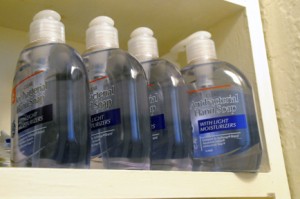Concerns raised over consumer antibacterial products in homes

From a young age, children are taught that frequent hand washing is one of the easiest ways to avoid disease-causing bacteria or viruses. Along this same vein, many hand soaps, dish detergents and household cleaning products on the market advertise the ability to kill 99.9 percent of all bacteria or microbes we come into contact with, attempting to keep surfaces cleaner and safer for families.
Even though research has shown that antimicrobial products can efficiently kill almost any bacteria or virus it contacts, are these chemicals really protecting consumers from illnesses, or do they create new problems?
A recent survey of 10 students at City College of San Francisco found that eight students did not think antibacterial soap was any more effective than regular soap.
“I wash my hands after going to the restroom, or before I eat,” City College student Albert Carson said. “I don’t really worry about using antibacterial soap specifically.”
According the Environmental Protection Agency’s Web site, consumers spend approximately $1 billion each year on a variety of antimicrobial products which contain a total of over 275 different ingredients designed to destroy or suppress the growth of harmful microorganisms.
The University of California in Davis has been studying antibacterial products to present their research to the EPA in October 2008 according to WebMD, a Web site dedicated to informing consumers about health issues. Through three different studies, researchers have discovered that triclosan, found in 76 percent of all liquid soap, and triclocarban, a common additive in antibacterial soap and deodorant, may potentially pose a threat to public health. According to the study results, these ingredients may affect sex hormones, and may interfere with the nervous system.
Bill Nye, a Cornell University graduate turned television scientist, is also critical of the chemicals.
“Triclosan was discovered in 55 percent of North American streams, in concentrations that allow it to act as an endocrine disrupter, affecting growth, metabolism and hormones. Seventy-five percent of triclocarban gets sloshed down the drain by handwashers only to survive waste water treatment and accumulate in municipal sludge, which is later used as fertilizer for crops that end up on our dinner plates,” Nye wrote on his Web site.
“Most of us should avoid antibacterial products, with people in the health care industry being the only exception. Our casual use of antibacterial products might even be breeding drug resistant super germs that cannot be squashed by antibiotics,” Nye said. “We have been living and dying with germs for millions of years, but antibiotics were discovered less than a hundred years ago. These drugs and chemicals have been very effective in knocking germs apart or disrupting their various internal chemical activities. But germs reproduce so fast we will never wipe them all out.”
Dial Corp., which introduced the first liquid soap specially formulated to kill germs with triclocarban in 1987, responded via e-mail to requests for comment about its products.
“Triclocarbon, the active ingredient used in Dial Soap, benefits consumers by providing deodorant protection and reduces the transmission of germs from one individual to another. The supplier and users of triclocarban have extensively studied it’s safety for more than 20 years. Studies using doses far exceeding those expected for human usage have shown no toxicity,” Dial Corp. wrote in the e-mail.
“There are 10 times more bacteria on our bodies as there are cells in our bodies,” said Carole Toebe, department chair for biological sciences at City College. “We need to make peace with the beneficial bacteria, not destroy them. The public is being mislead by a marketing campaign which tells us to attack 99.9 percent of germs. We need to question our uses of antibacterial products; they are appropriate when you need to up the ante in hospitals, but the need in the real world is unnecessary.”
Stuart Levy, a Tufts University School of Medicine professor of microbiology, thoroughly investigated the antibacterial products for his presentation at the Emerging Infectious Diseases Conference in 2000.
“When used correctly, they [antimicrobial products] inhibit bacterial growth. However, their purpose is not to cure disease, but prevent disease-causing microorganisms to non-infected persons,” said Levy. “Germs have become the buzzword for a danger people want to eliminate from their surroundings.”
Levy also cites studies that revealed an increase in allergies, cases of asthma, and eczema in people who were “raised in an environment overly protective against microorganisms.”
The Alliance for The Prudent Use of Antibiotics is also concerned with germ mutations and their treatment.
According to the APUA, “Experiments have found that some bacteria can combat triclosan and other biocides. These mutants were also resistant to several antibiotics.”
While the emergence of mutated super germs with the ability to resist antibacterial products may seem like the largest threat to our health, the true risk presented by antibacterial products may be our own cleaning routines.
“The use of these agents [antimicrobial products] creates a false sense of security that may cause individuals to become lax in hygiene habits,” the APUA said. “Antibacterial use should not be considered the alternative to normal hygiene, except where normal hygiene practices are impossible.”

Comments are closed.